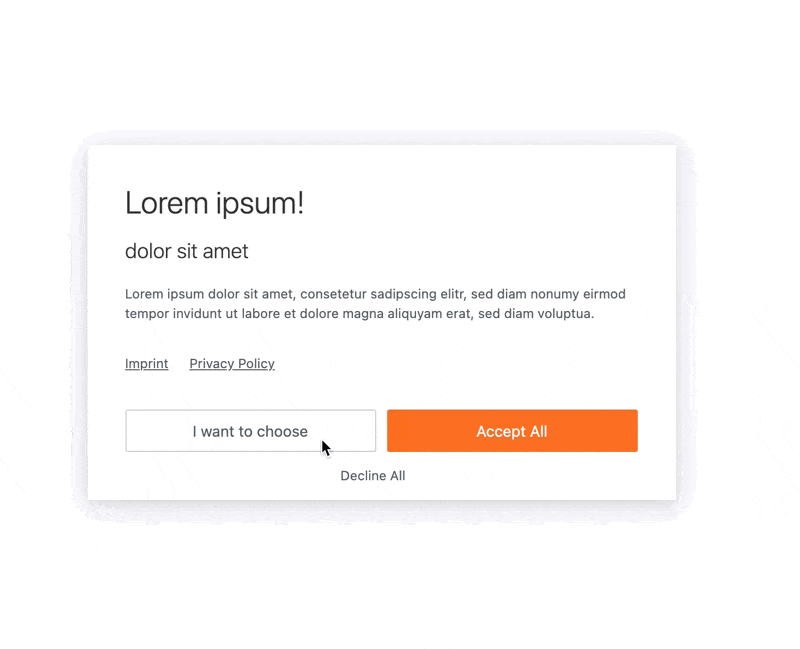mia-consent-manager v1.0.2
Moodley Interactive Consent Manager
This consent manager is meant to ease up compliance with the GDPR cookie regulations. Its an easy to install, lightweight NPM package that adds the consent decision to the GTM data layer. Therefore the scripts for which consent was given can be activated via GTM triggers. The decision will be stored as a cookie and saved for 12 months before consent has to be given again. If new scripts are added only consent for these is asked from the user.

Installation
npm install --save mia-consent-manager
Usage
import MiaConsentManager from 'mia-consent-manager'
import 'mia-consent-manager/bundle.css'
MiaConsentManager({
blocking: true, // if true the consent modal will cover the entire screen, if false it will be in the left bottom corner
homeText: {
title: 'Lorem ipsum!',
description:
'Lorem ipsum dolor sit amet, consetetur sadipscing elitr, sed diam nonumy eirmod tempor invidunt ut labore et dolore magna aliquyam erat, sed diam voluptua.',
subtitle: 'dolor sit amet', // this is optional
},
chooseText: {
title: 'Lorem ipsum!',
description:
'Lorem ipsum dolor sit amet, consetetur sadipscing elitr, sed diam nonumy eirmod tempor invidunt ut labore et dolore magna aliquyam erat, sed diam voluptua.',
},
highlightColor: '#fc6e20',
sliderColor: '#fe886c',
privacyLink: '/privacy',
imprintLink: '/imprint',
infoButtons: [{ // adds additional buttons next to the imprint and privacy links
href: 'https://google.at',
label: 'GOOGLE'
}],
language: 'en', // de, en are available
scripts: [
{
name: 'Google Analytics',
description: 'Allows us to analyze the statistics of visits to our site',
domain: 'google.com',
scriptId: 'gascript', // if set the script tag with this ID gets enabled. This can be used if GTM is not used to toggle scripts
gtm: {
grantEvent: 'GOOGLE_ANALYTICS',
},
info: [{
label: 'Name',
description: 'Google Analytics'
}, {
label: 'Provider',
description: 'Google LLC'
},{
label: 'Domain',
description: '<a href="https://google.at">google.at</a>'
}]
},
{
name: 'Linked-In',
description: 'Allows us to analyze the statistics of visits to our site',
domain: 'linkedin.com',
gtm: {
grantEvent: 'LINKED_IN',
},
},
],
})Browser Support
According to this specification:
http://browsersupport.moodley-interactive.com/
Usage with Google Tag Manager
The consent manager provides Grant Events and Status Cookies for the usage in your GTM setup.
Grant Events are standard Data Layer events prefixed by CM_GRANTED\* resulting in events like CM_GRANTED_GOOGLE_ANALYTICS, CM_GRANTED_LINKED_IN according to the settings file. Each page view fires a grant event for each given consent, so you can use them as triggers.
Status Cookies are standard first-party-cookies prefixed by CM_\* resulting in cookies like CM_GOOGLE_ANALYTICS, CM_LINKED_IN according to the settings file. Each consent sets status cookie with the value true for consent given or false for consent denied. You can use them for more complex solutions or blocking triggers.
Usage without Google Tag Manager
If no GTM is used the consent manager can be used to enable tools that were added via a script tag directly.
But you have to modify the script tag beforehand
This is how an example GA tag would look like
<!-- Google Analytics -->
<script>
(function(i,s,o,g,r,a,m){i['GoogleAnalyticsObject']=r;i[r]=i[r]||function(){
(i[r].q=i[r].q||[]).push(arguments)},i[r].l=1*new Date();a=s.createElement(o),
m=s.getElementsByTagName(o)[0];a.async=1;a.src=g;m.parentNode.insertBefore(a,m)
})(window,document,'script','https://www.google-analytics.com/analytics.js','ga');
ga('create', 'UA-XXXXX-Y', 'auto');
ga('send', 'pageview');
</script>
<!-- End Google Analytics -->But it has to be modified like so:
<!-- Google Analytics -->
<script type="application/json" id="mygatag" >
(function(i,s,o,g,r,a,m){i['GoogleAnalyticsObject']=r;i[r]=i[r]||function(){
(i[r].q=i[r].q||[]).push(arguments)},i[r].l=1*new Date();a=s.createElement(o),
m=s.getElementsByTagName(o)[0];a.async=1;a.src=g;m.parentNode.insertBefore(a,m)
})(window,document,'script','https://www.google-analytics.com/analytics.js','ga');
ga('create', 'UA-XXXXX-Y', 'auto');
ga('send', 'pageview');
</script>
<!-- End Google Analytics -->note: The type application/json was set, this "disables" the script tag initially.
We also added an ID to the tag, this ID must be set in the config (scriptId).
After the user granted the script the type will be changed to text/javascript and therefore enable the script.
CSS Styling
Styling follows the BEM syntax; every class is prefixed with miconsent and existing styles can easily be overwritten by using:
.miconsent .miconsent__[element] Possible Design Adjustment
Highlight and slider colors can be changed using the JS settings. All other styling can be adjusted using CSS overwrites.
5 years ago
5 years ago
5 years ago
5 years ago
5 years ago
5 years ago
5 years ago
5 years ago
5 years ago
5 years ago
5 years ago
5 years ago
5 years ago
5 years ago
5 years ago
5 years ago
5 years ago
5 years ago
5 years ago
5 years ago
5 years ago
5 years ago
5 years ago
5 years ago
5 years ago
6 years ago
6 years ago
6 years ago
6 years ago
6 years ago
6 years ago
6 years ago